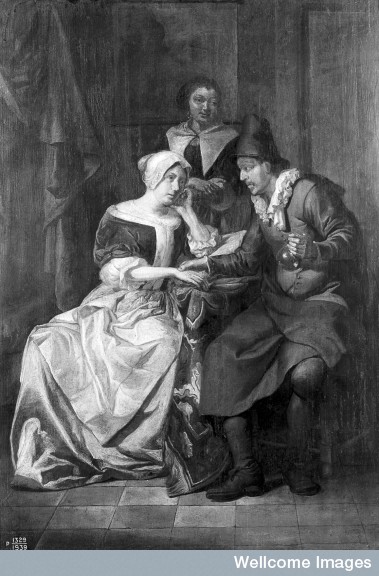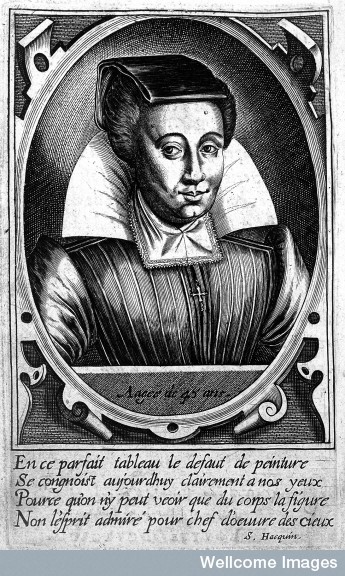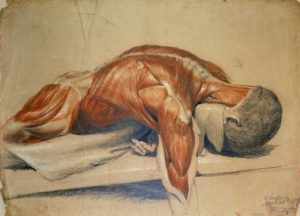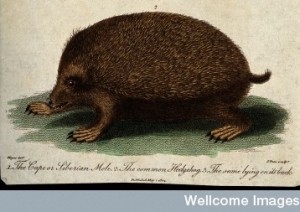Seduction, Sex and Medical Practice
I have recently been considering the relationship between male medical practitioners and female patients in the early modern period. Much work has been carried out by scholars on this very issue. Traditionally it was argued that physicians – those who had studied at university and focused their practice on internal medicines that redressed the balance of the humours – didn’t touch their patients, beyond taking a pulse.1 As can be seen in this picture touching a female patient even to take a pulse was often conducted in the presence of another person in order to maintain modesty. However, other practitioners such as surgeon, man-midwives and midwives touched their patients more extensively, to both diagnose illness and cure it.
practice on internal medicines that redressed the balance of the humours – didn’t touch their patients, beyond taking a pulse.1 As can be seen in this picture touching a female patient even to take a pulse was often conducted in the presence of another person in order to maintain modesty. However, other practitioners such as surgeon, man-midwives and midwives touched their patients more extensively, to both diagnose illness and cure it.
Touch was particularly important in certain contexts. Perhaps the most widely considered of these was gynaecological and obstetrical treatments. Midwives built some of their authority on their ability to touch the female body; they were also heavily criticised by their detractors for excessively touching women. Male practitioners argued that female midwives stretched the labia and vagina unnecessarily in order to facilitate childbirth. Even if female midwives were excessively vigorous, we know that in most circumstances they did have easy access to the female body. They were not hindered by gendered ideas of modesty.
Conversely male practitioners had to negotiate both visual and tactile access to the female body. In her book on midwifery in France, Lianne McTavish explains how French royal midwife Louise Bourgeois (pictured below) highlighted the problems associated with male birth attendants:
 ‘One day I found myself at the lying-in of a young noblewoman, a good friend of mine whose husband was away; she was being helped by three or four of her friends, who asked me what was the state of her delivery. I told them that the child was coming poorly, but that I would have it, helping God, without danger to either mother or child. They asked me to be so kind as to have a surgeon see her. To relieve them, I conceded, provided that she did not see him, for I knew that might cause her to die of dread and shame’2
‘One day I found myself at the lying-in of a young noblewoman, a good friend of mine whose husband was away; she was being helped by three or four of her friends, who asked me what was the state of her delivery. I told them that the child was coming poorly, but that I would have it, helping God, without danger to either mother or child. They asked me to be so kind as to have a surgeon see her. To relieve them, I conceded, provided that she did not see him, for I knew that might cause her to die of dread and shame’2
McTavish points out that there were women present who clearly wanted the surgeon to access and assess the female body, but the midwife believed that this would cause the patient dread and shame. Bourgeois assumed that exposing the patient’s body to anyone other than her husband was inappropriate. The main fear surrounding male access to the female genitalia was that it would cause arousal.3 People were concerned that experiencing these erotic sensations could be sinful for the woman, and that arousal was a motivating factor of men who entered this line of work; men used the access they gained to women’s bodies for their own erotic pleasure. Indeed there was some concern that male medical practitioners would assault or seduce their female patients leading to illicit sexual behaviour and adultery; in some cases these concerns were not unfounded.4 These concerns were widely discussed and found their way into early modern jokes and popular literature. This is perhaps not surprising given that laughter was one way of helping to dispel fears and anxieties and a means of demonstrating the cohesive views of society on particular issues.5 Nugae Venales: Or A Complaisant Companion: Being New Jests, Domestick and Foreign (1675) included the joke, in which a lecherous old doctor convinced a beautiful and naive young woman that the only way to cure her illness was to have sex with her. He claimed that she was ‘breeding eggs’ which he needed to break.
In my own research I was also concerned about these sorts of issues and discussed the possibility that doctors, rather than surgeons or midwives, used aromatic substances in order to diagnose and treat one particular intimate disorder, barrenness. These fumes and smells were thought to penetrate the internal cavity of the female body revealing the truth of a woman’s fertility. Moreover, smells originating from certain well-known aphrodisiacs were used to treat barrenness; they warmed the and sexually stimulated the womb encouraging fertility and sexual pleasure. These were introduced into the body in several ways: the woman could crouch over a fume; she might sit on a specially designed stool with a hole that allowed the fume pass up towards her body; a tunnel or funnel could be used to channel the smell into the womb; she could wear perfumed gloves; and finally the aromatic substance could be applied to her husband’s penis just before intercourse – which then conveyed the smell directly into the womb.
 Several of these methods, as may be apparent, could be done without the physician’s aid, and in some cases without his presence. In my research I suggested that using this form of treatment could allow male practitioners and patients to negotiate access to the female body. Physicians could possibly have used these diagnostic methods and treatments when women had refused to let them view or touch the body. Like other scholars, I was primarily interested in thinking about how doctors might have worked around the limitations of shame and modesty. Moreover, I was interested in how these diagnostic tests may have allowed women a way of establishing their fertility for themselves and avoiding the shame of being viewed and touched by a physician.
Several of these methods, as may be apparent, could be done without the physician’s aid, and in some cases without his presence. In my research I suggested that using this form of treatment could allow male practitioners and patients to negotiate access to the female body. Physicians could possibly have used these diagnostic methods and treatments when women had refused to let them view or touch the body. Like other scholars, I was primarily interested in thinking about how doctors might have worked around the limitations of shame and modesty. Moreover, I was interested in how these diagnostic tests may have allowed women a way of establishing their fertility for themselves and avoiding the shame of being viewed and touched by a physician.
But perhaps these concerns and these inappropriate intimacies were not always initiated by a lecherous doctor. Although, this might be the easier story to tell because it neatly reflects the anxieties early modern society had about chastity and modesty, it is not the only story to tell. Several scholars have suggested that fears about modesty, although very real, were not a barrier to medical practice.6 More than this, however, in some cases it would seem that it was women themselves who encouraged illicit sexuality.
The following anecdote about venereal disease treatment (yes v.d. seems to be a very strong recurring theme in the blog at the moment) was recited by John Browne in The Surgeons Assistant (1703). In this case it was clearly the woman who manipulated the medical situation she was in, in order to satisfy her own sexual desires. Although, the surgeon needed little encouragement.
‘an Observation of a Woman, who being Pox’d, would not believe she was cured till her Surgeon had try’d her; he readily consented to the agreement; but she gave him those close marks of her case, that he never could get well off from it all his days; and I assure you this was undertaken by none of the meanest Surgeons of the City of London; who, tho he kept his Coach, lived as Deaf as a Dormouse, and [was] consumed daily, by this his Tryal of Skill.’7
Now this source is clearly not unproblematic. It was probably recited to highlight the surgeon’s folly, both in his willingness to have sex with a patient and in having faith in his own lacklustre medical abilities. Once the woman has had sex with the surgeon she disappears from this story, indeed her role appears relatively small in the grander narrative. Yet it is made clear that it was the woman who initiated this sexual liaison with someone who had been treating her for an intimate disease, and who had potentially already seen and handled her genitalia. The woman appears sexually assertive and in control of this situation. Through her insistence on sexual activity she damages the surgeon’s reputation and leaves him appearing not only foolish but permanently damaged. It is likely that a part of this tale, like many venereal disease observations, was designed as a warning about the hazards of sexual activity with pocky, or ex-pocky, people. Nonetheless, it feeds into these debates about the contact between patients and practitioners and highlights that this is a particularly problematic issue to attempt to unpick.
[My research on fumes, smells, aromatics and barrenness is discussed in much greater detail in ‘Female Barrenness, Bodily Access and Aromatic Treatments in Seventeenth-Century England’, forthcoming Historical Research]
1 For examples see: Andrew Wear, Knowledge and Practice in English Medicine, 1550-1680 (Cambridge: Cambridge University Press, 2000), pp.120-122; Sandra Cavallo, Artisans of the Body in Early Modern Italy: Identities, Families and Masculinities (Manchester: Manchester University Press. 2007).
2 Lianne McTavish, Childbirth and the Display of Authority in Early Modern France (Aldershot: Ashgate, 2005), p.57.
3 Winfried Schleiner, Medical Ethics in the Renaissance (Washington: Georgetown University Press, 1995), p 109. Hilary Marland, The Art of Midwifery: Early Modern Midwives in Europe (London: Routledge, 1993), p. 39; Roy Porter ‘a touch of danger: the man-midwife as sexual predator’ in Sexual Underworlds of the Enlightenment, Roy Porter and G. S. Rousseau (eds), (Manchester: Manchester University Press, 1987), pp. 206-232;
4 Hilary Marland, The Art of Midwifery: Early Modern Midwives in Europe (London: Routledge, 1993), p. 39; Roy Porter ‘a touch of danger: the man-midwife as sexual predator’ in Sexual Underworlds of the Enlightenment, Roy Porter and G. S. Rousseau (eds), (Manchester: Manchester University Press, 1987), pp. 206-232.
5 Keith Thomas, ‘The Place of Laughter in Tudor and Stuart England’ Times Literary Supplement (London, England), Friday, January 21, 1977; p. 77; Issue 3906.
6 Wendy D. Churchill, Female Patients in Early Modern Britain: Gender, Diagnosis and Treatment (Aldershot: Ashgate, 2012), p. 64.
7 John Browne, The Surgeons Assistant. In which is plainly discovered the True Origin of most Diseases. Treating particularly of the Plague, French Pox, Leprosie, &c. … (London, 1703), p. 65.
© Copyright Jennifer Evans, all rights reserved.



It is my understanding that western medical knowledge was lacking in terms of female anatomy and physiology because of the social stigma of dissecting female cadavers. I have been unable to find any information in this regard, nor can I find any reference to a time when female cadavers were used. If you could guide me in a direction where I may find this information I would be greatly appreciative.
Hi Brett,
There were fewer cadavers available to dissect for the female body, but it does depend where you are considering. Dissections was not really allowed in Britain before the 16th century, but were occurring in other countries. However, across the early modern period many discoveries about the reproductive bodies were made including the female body. I tend to think that it is a little bit of an overstatement to say that the female body was mysterious (This is perhaps why it isn’t discussed explicitly in the historical literature)
There are some really good books on anatomy and dissection in this era such as:
Cunningham, Andrew, The Anatomist Anatomis’d (Ashgate: 2011)
Ferrari, G., ‘Public Anatomy Lessons and the Carnival: The Anatomy Theatre of Bologna’, Past & Present (No. 117, 1987), pp.50-106
Knight, Bernard, Discovering the Human Body: How pioneers of medicine solved the mysteries of anatomy and physiology, (London, 1980)
Park Katharine, Secrets of Women: Gender, Generation and the Origins of Human Dissection (New York: Zone Books, 2006)
Berriot-Salvatore, Evelyne, ‘The Discourse of Medicine and Science’, in Zemon Davis, Natalie and Farge, Arlette (eds.), A History of Women: Renaissance and Enlightenment Paradoxes, (Cambridge, Mass. and London, 1993), pp.348-394
Cunningham, Andrew, The Anatomical Renaissance: The Resurrection of the Anatomical Projects of the Ancients, (London, 1997)
Sawday, Jonathan, The Body Emblazoned: Dissection and the Human Body in Renaissance Culture, (London and New York, 1995), Chapter 5, ‘Sacred Anatomy and the Order of Representation’, pp. 85-140